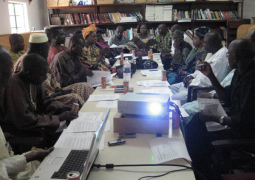“This represents an increase of 18 per cent in the authority’s annual revenue between 2012 (D633 million) and 2013 (D733 million),” he said.
He said traffic throughput decreased from 1,615.328 tonnes (2012) to 1,590,070 tonnes in 2013 representing a decrease of 2 per cent.
The GPA chairman was speaking on Tuesday at the National Assembly when presenting the GPA annual report for 2013 for discussion and adoption by the joint session of the PAC/PEC.
“This is mainly as a result of a decrease in the export of agricultural products such as timber, groundnuts, and later start of the sand (zircon) export,” Mr Colley said.
These throughput figures also excluded liquid bulk (petroleum products) of 232,473 tonnes that was handled by Gam Petroleum Limited as its storage facilities at Mandinary, he added.
The GPA chairman further informed the Assembly’s joint committees’ session that the authority had continued to maintain a dedicated workforce and a management team “responsive and committed to providing a high-level customer service.”
“As a multi-purpose port catering for containerized, break bulk, liquid and dry bulk , as well as neo-bulk cargoes and terminal facilities, the port provides its customers with acceptable, expeditious and value for money services 24 hours and all-year round,” Colley told deputies.
He said the GPA having realised the importance of a well-educated, trained, skilled and healthy population had continued to contribute “tremendously” to the socio-economic development of The Gambia, through sponsorship programmes and interventions in various sectors of the economy, such as health, education and agriculture.
Read Other Articles In Article (Archive)
The rainy season is fast approaching
Apr 30, 2013, 9:59 AM
Diocese of Banjul Embarks on Family Support Groups Project
Jun 4, 2008, 7:15 AM



